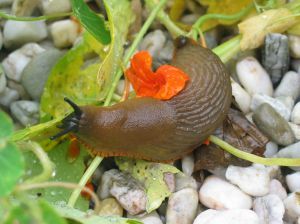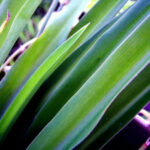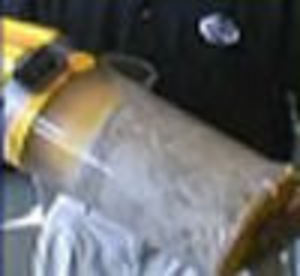Slugs that make their homes in your garden can cause some serious damage to your plants. Without knowing it you can plant and design an entire garden that meets every dietary and habitat need slugs have.
Fortunately, there are several things you can do to prevent and stop slug damage to your plants. Knowing where slugs prefer to live, when they are a problem, how to detect slugs and their preferences in plants is the best way to combat slugs. This information and other natural ways of dealing with slugs are effective and safe ways to stop slug damage naturally.
How to Detect Slug Damage
Slugs leave telltale signs that they are the culprits wreaking havoc on your prized hostas and other plants. In order to determine that the damage is coming from slugs though and not another pest look for three signs. The first tell tale sign are large holes that begin appearing in the leaves of your plants, refer to the list of plants that slugs prefer later in this article.
If there are holes in the leaves of plants that slugs prefer then there is a really good chance that you are providing a slug colony with their daily meals. Look around the damaged plants for two other signs of slugs, the first being trails of slime on leaves and rocks and small pearly eggs. If you find two of the three signs read on to find out where they live and how to naturally stop slugs in their path.
Know Where Slugs Live
If you notice slug damage in your garden fight slugs where you are most likely to find them, where they live. Slugs prefer wet and damp areas of your garden to live in. The more protected an area is from the sun, which dries slugs out, the more slugs you are bound to find.
Another area slugs prefer to hide and nest in during the day is any location with a lot of ground cover such as leaves, stones, and other yard waste and debris. Once you start noticing signs of pest damage clear any areas of debris around your plants to help minimize the effect of slugs.
Know When Slugs Cause the Most Damage
Just when you think you have your slug problem under control a whole new army of pests is released on your garden and ready to enjoy themselves. Eggs are laid in the first couple of weeks of summer and need only three to four weeks to hatch, so it is at this time that your plants will begin to show damage and quickly. Make sure you ar eready to deal with the pests very early in the growing season and minimize their damage before they devour entire plants.
Natural Ways to Fight Slugs
In addition to clearing debris, as I mentioned earlier, there are a couple other ways to deal with slugs naturally. One of the best and easiest ways to deter slugs from crawling onto your plants is to make it impossible for them to get near the plants. By placing a barrier of sharp and rough objects around the plants that are being eaten you make it impossible for the slugs to get near their meal. Slugs have soft bodies that they need to protect, crushed up eggshells or mulch cause harm to their soft bodies.
Because we know that slugs like to rest and hide under stones and logs place a few stones around your plants to act as bait. Regularly check the stones for slugs and dispose of the ones you find. Another easy and natural way to deter slugs is to lure them from your plants with a shallow dish of lemonade or beer. Once the slugs make their way into the liquid they will not be able to get back out.
Finally, you can create another barrier around your plants with other plants, plants that slugs do not like that is.
The following plants are avoided by slugs for various reasons; roses, cacti and succulents, herbs, and dusty miller. Tulips, hostas, lettuce, sweet pea, strawberries and Delphiniums are all plants that slugs prefer and will eat till nothing is left. Watch these plants all summer long for signs of slugs and use any of the natural remedies described to keep your slug population under control.






